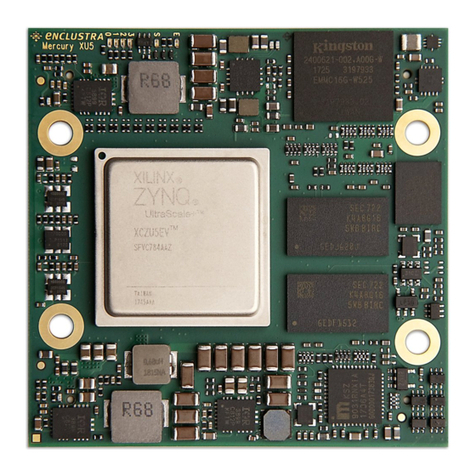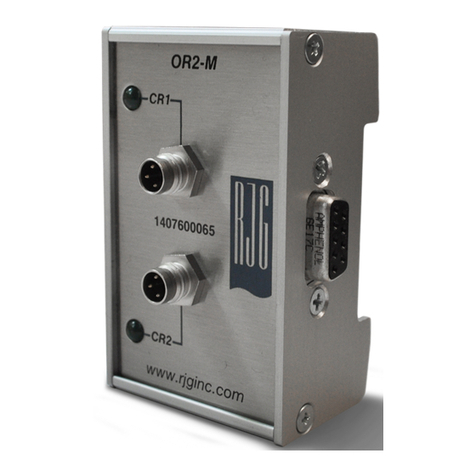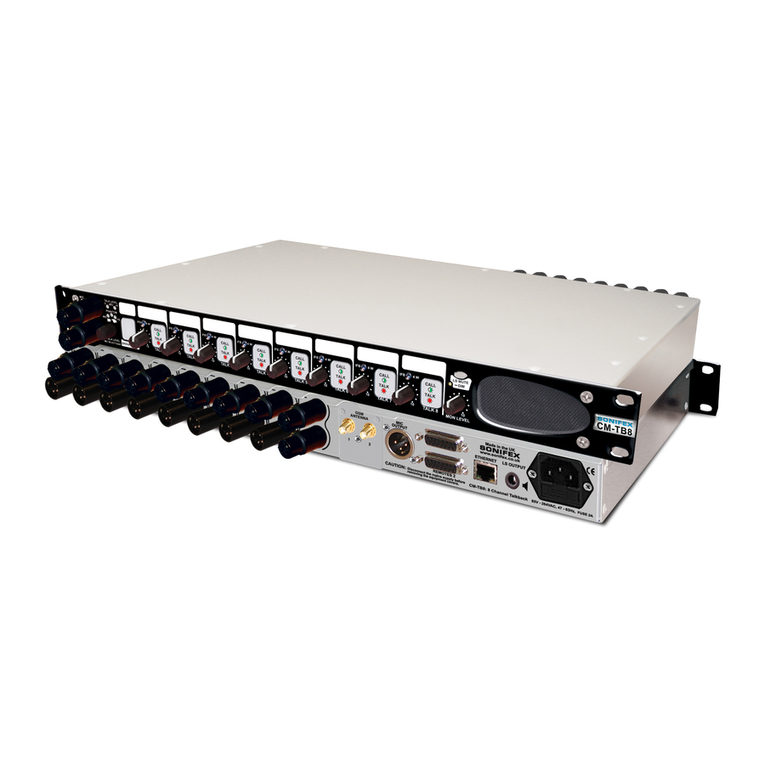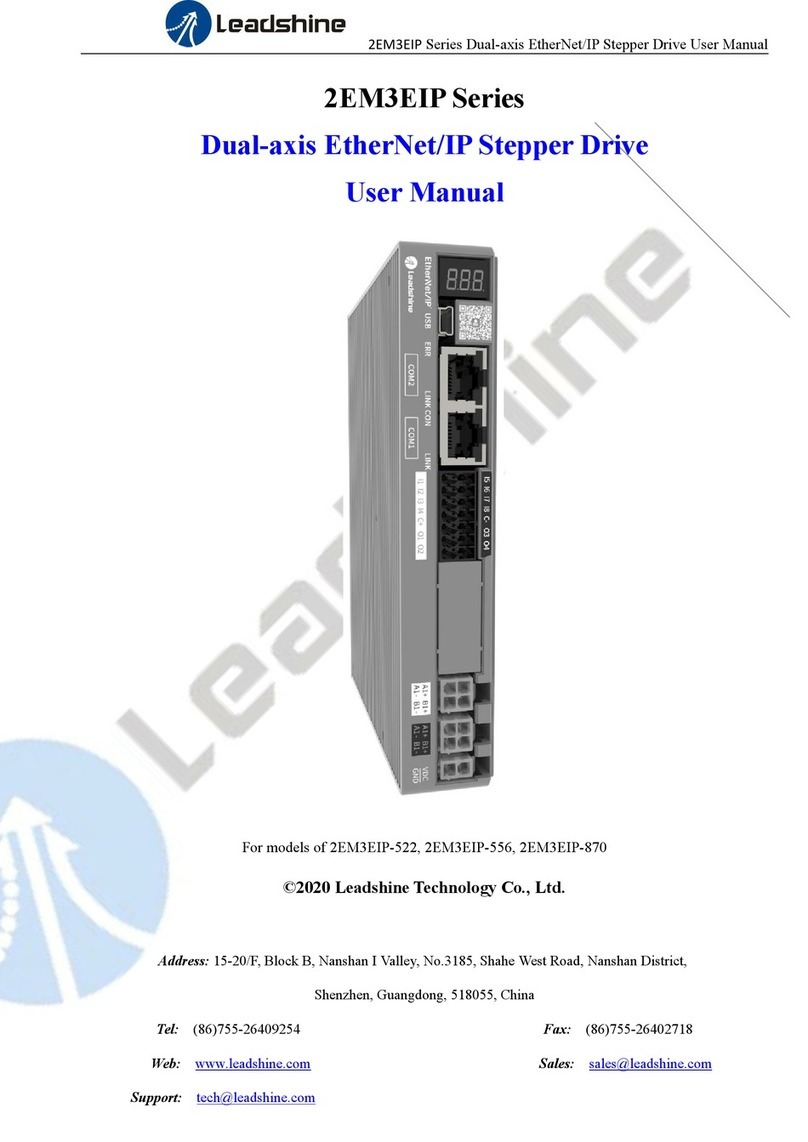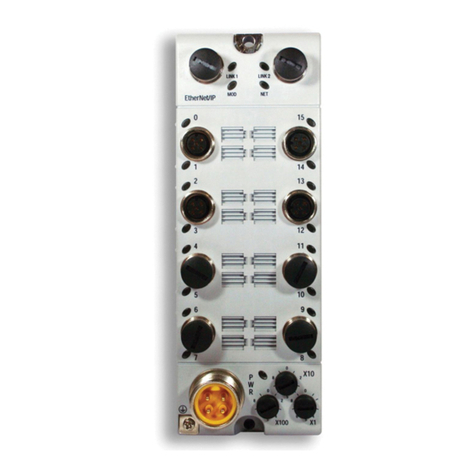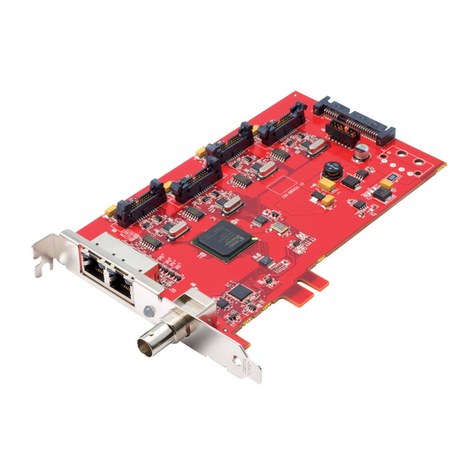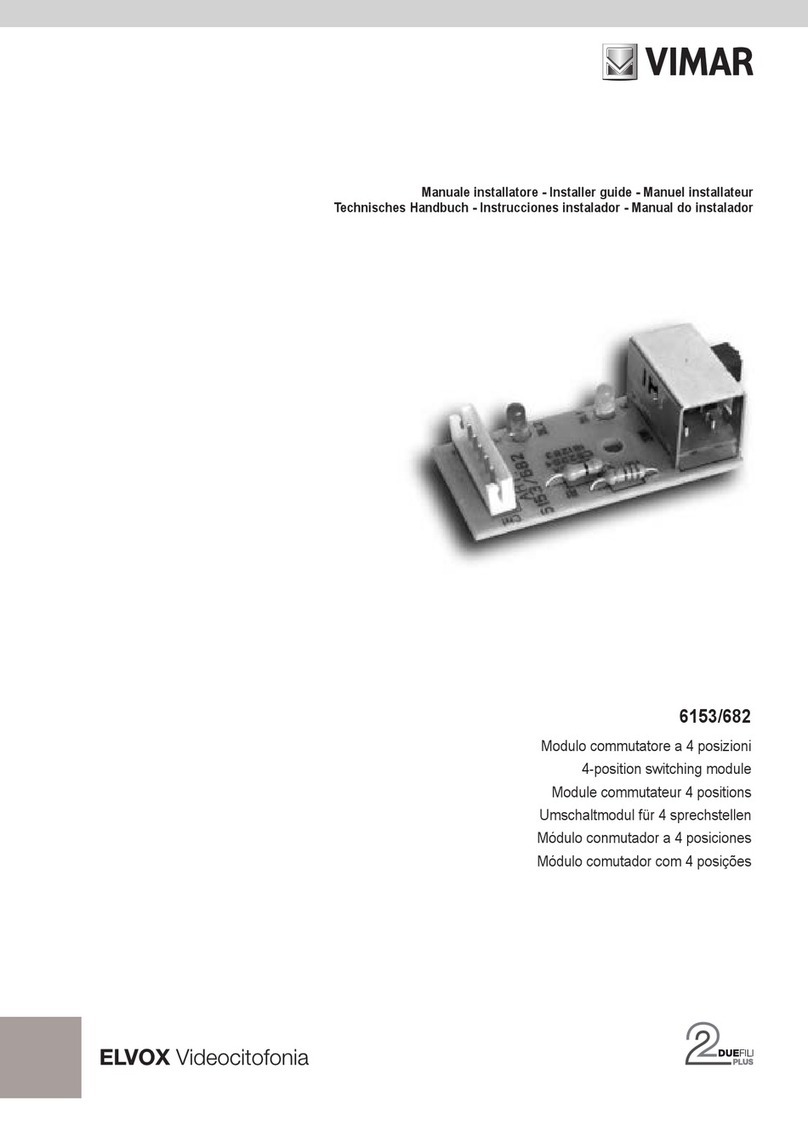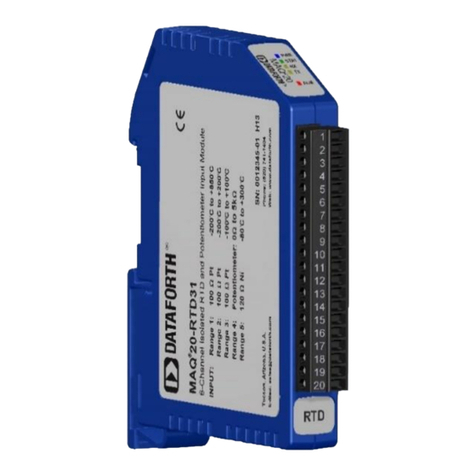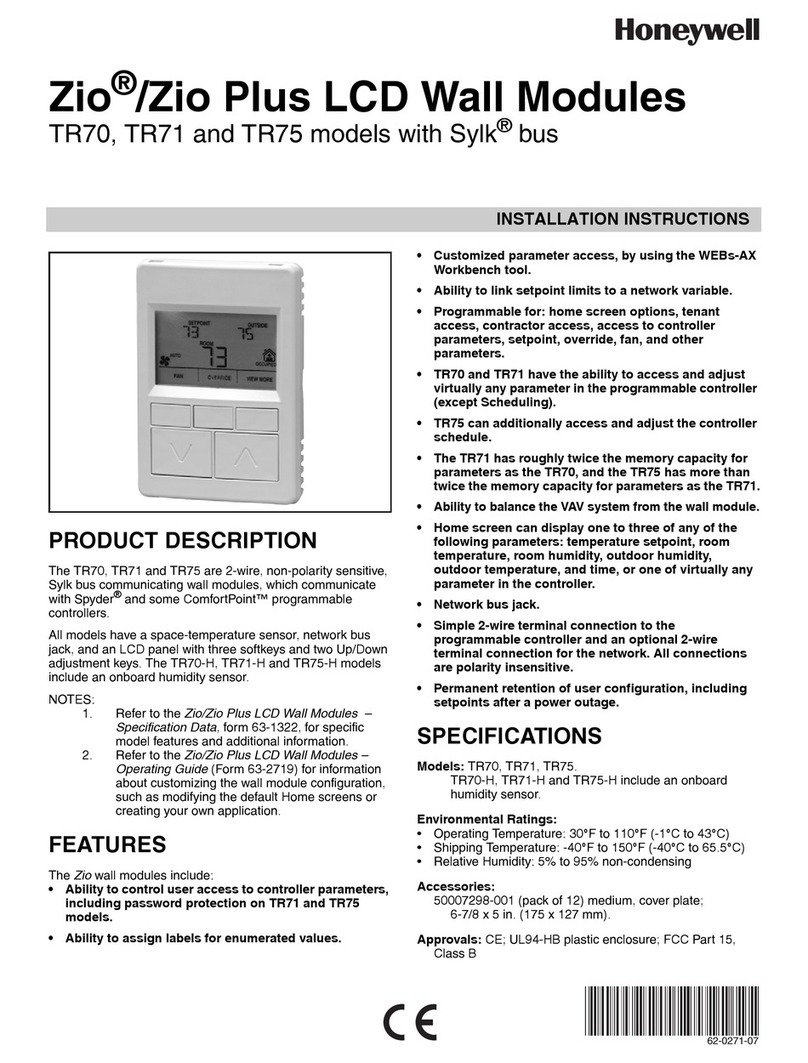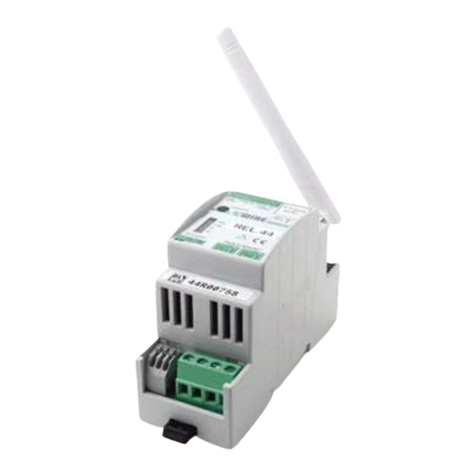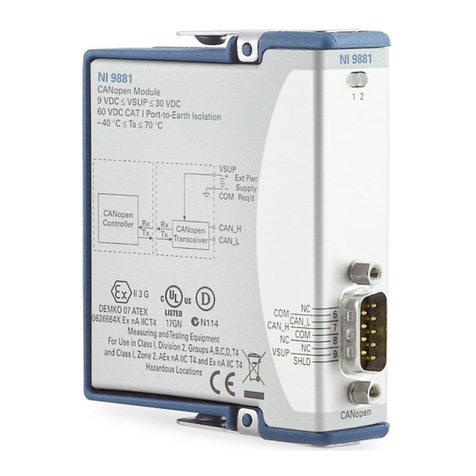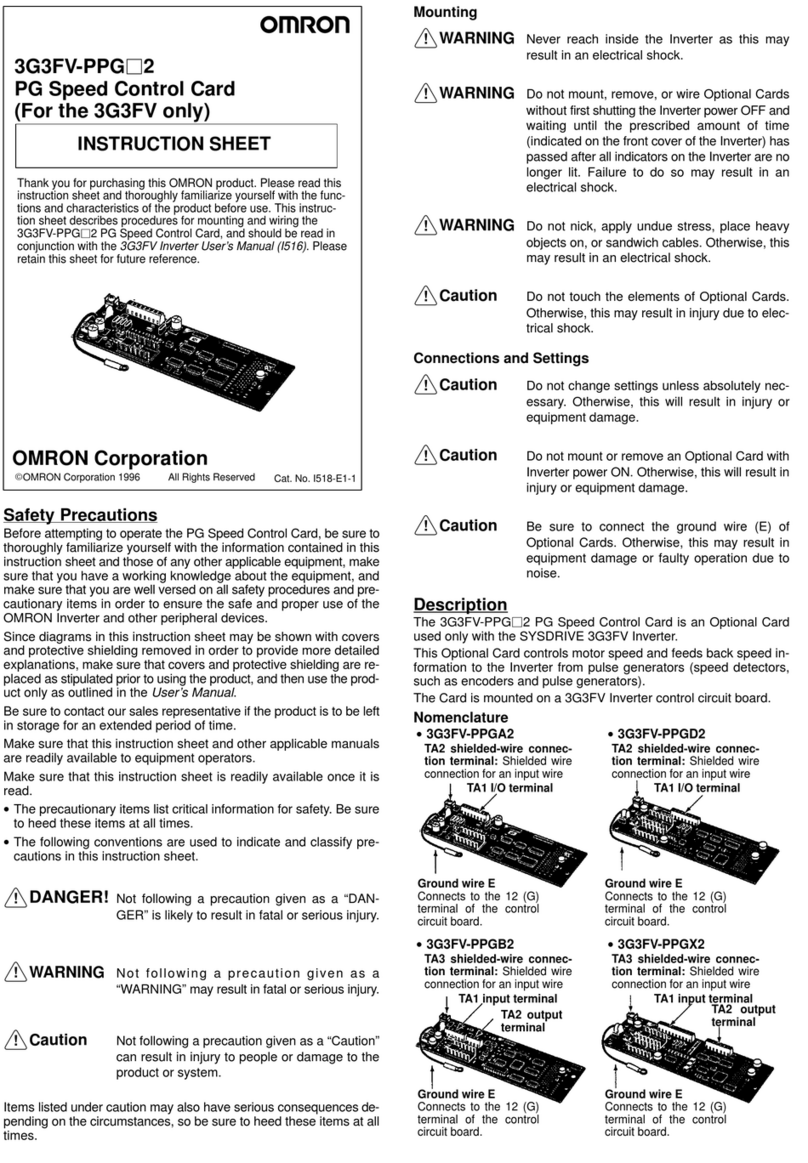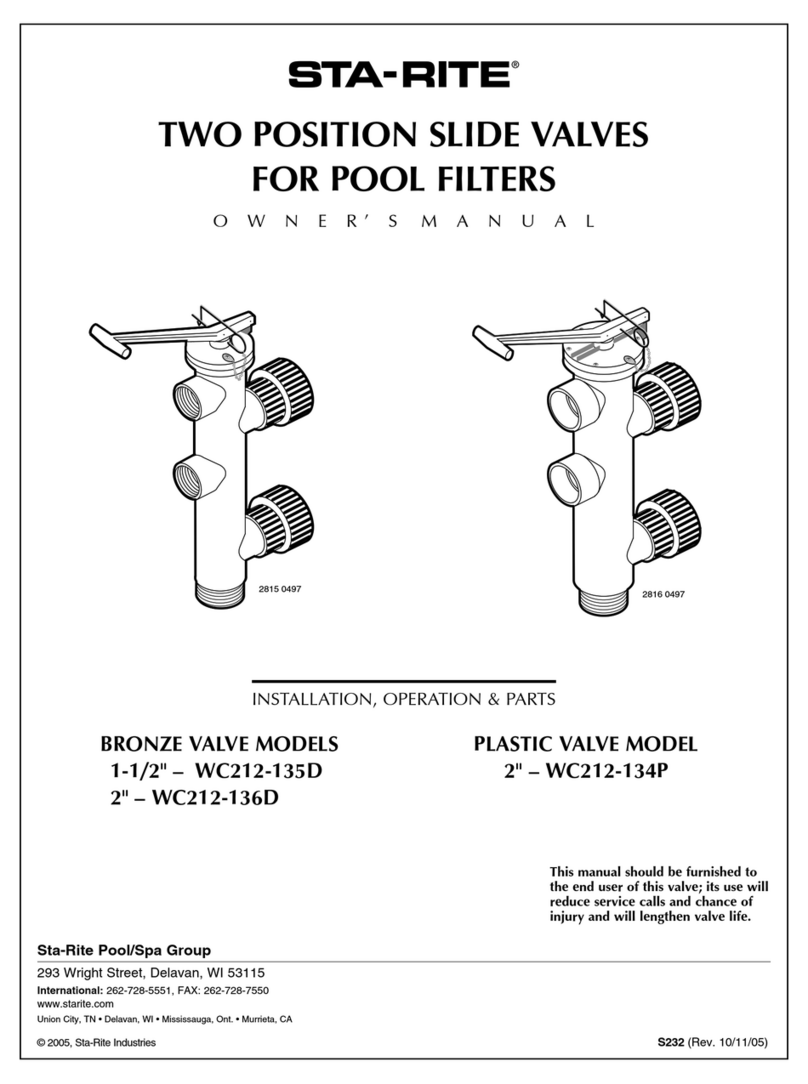GF Piping Systems NeoFlow User manual

GF Piping Systems
Operating instructions
NeoFlow Pressure Reducing Valve DN50 - DN150
The NeoFlow Pressure Reducing Valve is co-developed with OFUI
1276507
GFDO_MA_00049 / 1a (05.2021)
© Georg Fischer Piping Systems Ltd
8201 Schahausen/Schweiz

GF Piping Systems
English 1
Deutsch 45
French 89
Spanish 133
Italian 177
Portuguese 221
Nederlands 265
Chinese 309
The nNeoFlow Pressure Reducing Valve is co-Developed with OFUI

GF Piping Systems
Instruction manual
NeoFlow pressure reducing valve
DN50 - DN150

GF Piping Systems
Translation of the original instruction manual
Disclaimer
The technical data within this document is not binding. It does not constitute expressly warranted characteristics, guaranteed properties
or guaranteed durability. It is subject to modification. Our General Terms of Sale apply.
Observe instruction manual
The instruction manual is part of the product and an important element within the safety concept.
►Read and observe instruction manual.
►Always have instruction manual available by the product.
►Give instruction manual to all subsequent users of the product.

3
Instruction manual NeoFlow pressure reducing valve
Table of contents
1 Product description 5
1.1 Intended use 5
1.2 EC Manufacturer's declaration 5
1.3 Technical data 6
2 Safety Information 7
2.1 Observe instruction manual! 7
2.2 Commissioning and use by qualified personnel only 7
2.3 Storage and transport 7
2.4 Warning signals 7
2.5 Other applicable documents 8
2.6 Pressure test of piping systems 8
3 Further symbols and abbreviations 8
3.1 Symbols 8
3.2 Abbreviations 8
4 Design and function 9
4.1 Subassemblies 9
4.2 Designations of the valves 9
4.3 Mode of operation 10
5 Installation process 11
5.1 Carrying out the basic setup 11
5.2 Installation area 14
5.3 Installation 16
5.4 Initial operation 18
6 Operation 20
6.1 Setting outlet pressure P2 20
7 Service 22
7.1 Regular valve inspection 22

4
Instruction manualNeoFlow pressure reducing valve
7.2 Cleaning filter and control system 23
7.3 Removal of the NeoFlow pressure reducing valve 26
7.4 De-installation of the control system 28
7.5 Maintenance of the control system 30
8 Troubleshooting 36
8.1 Reducing outlet pressure fluctuations 36
8.2 Flow chart A 38
8.3 Flow chart B 39
9 Disposal 40
10 Spare parts list 40
10.1 Spare parts sets 40
10.2 Pilot spring 40
11 Accessories 41
11.1 Manometer connections (optional) 41
11.2 Regulator compatibility overview 41
12 Components and subassemblies 42
12.1 General overview 42
12.2 Main Body 42
12.3 Control block 43
12.4 Pilot valve 43

5
Instruction manual NeoFlow pressure reducing valve
1 Product description
1.1 Intended use
The pilot-controlled NeoFlow pressure reducing valve from GF Piping Systems was designed for the automatic pressure and flow
control in networks for the supply and distribution of water.
The NeoFlow pressure reducing valve is designed to fit between standard PN10/PN16 flanges in a wafer-type arrangement. ANSI150
flange compatibility is also available (excl. DN80).
Foreseeable misuse
The NeoFlow pressure reducing valve may not be used as a pure shut-o valve. Media other than water as well as water containing
an amount of disinfectant may only be used in consultation with a contact partner from GF Piping Systems. The use of solid matter
in the medium can aect the function of the NeoFlow pressure reducing valve. For this reason, use is only recommended with an
upstream strainer.
1.2 EC Manufacturer's declaration
The manufacturer Georg Fischer Rohrleitungssysteme AG, 8201 Schahausen (Switzerland) explains that the NeoFlow pressure
reducing valve fully complies with the standard “EN 1074-5 Valves for water supplies.”
If the overall system does not comply with the requirements of an EC directive, then putting the NeoFlow pressure reducing valve is
prohibited until the conformity of the overall system with the EC directive has been declared.
Fittings Involved standards
NeoFlow Pressure reducing valve EN 1074-5
Changes to the fittings that could eect the stated technical data and the intended use, void this manufacturer's declaration.
Additional information can be found in "GF planning fundamentals.”
Schahausen, April 29, 2021
Bastian Lübke
Head of Global R&D
Georg Fischer Piping Systems Ltd.
CH-8201 Schahausen (Switzerland)

6
Instruction manualNeoFlow pressure reducing valve
1.3 Technical data
1.3.1 Specifications
Specifications
Pressure ratings and perfor-
mance
Maximum inlet pressure P1 16 bar*
Maximum outlet pressure P2 16 bar**
Outlet pressure range 0.1 to 16 bar**
Minimal pressure dierence P1– P2 0.2 bar***
Materials Casing POM-C
Piston POM-C
Elastomers EPDM
Fittings Stainless Steel / Brass
Pilot control Stainless steel, POM-C, PTFE
Flanges Metric: PN10/16 Imperial: ANSI 150
*With medium temperature ≤ 20°C; >20°C on request **Depending on the pilot valve type ***Dependent on flow and size
1.3.2 Kv 100 values
DN
(mm)
Inch
(")
Kv 100
(m3/h)
Kv 100
(l/min)
Cv 100
(US gal./min)
DN50 2 30 500 132
DN80 - 73 1217 321
DN100 4 130 2167 572
DN150 6 266 4433 1171
1.3.3 Flow rate
Pipe diameter Maximum flow in l/s with a given speed V
DN Inch V =1 m/s V = 1.5 m/s V = 3 m/s*
(mm) (") (l/s) (l/s) (l/s)
DN50 2 2 3 6
DN80 - 5 8 15
DN100 4 8 12 24
DN150 6 18 27 53
*recommended maximum

7
Instruction manual NeoFlow pressure reducing valve
2 Safety Information
2.1 Observe instruction manual!
The instruction manual is part of the product and an important component within the safety concept. Non-observance may lead to
severe injuries.
• Read and observe instruction manual.
• Always have instruction manual available by the product.
• Give instruction manual to all subsequent users of the product.
2.2 Commissioning and use by qualified personnel only
• Product and accessories should be exclusively put into operation by persons who have the necessary training, knowledge, or
experience.
• Regularly instruct personnel on ll uestions regrding the locl regultions pplying to occuptionl sfety nd environmen-
tl protection, especilly for pressurized pipes.
The following target groups are addressed in these operating instructions:
• Operators: Operators are instructed in the operation of the product and observe the safety guidelines.
• Service sta: The service sta have been professionally trained and carry out maintenance work.
2.3 Storage and transport
The product must be handled, transported and stored with care. Please note the following points:
►Transport and store the product in its unopened original packaging.
►Protect the product from harmful physical influences such as dust, heat, humidity and UV radiation.
►The product and its components must not be damaged either by mechanical or thermal influences.
►Store the product with the lever in the open position (delivery state).
►Check the product for general damage prior to installation.
2.4 Warning signals
In this instruction manual, warnings are used, which shall warn the user of death, injuries or material damage. Always read and
observe these warnings!
DANGER!
Imminent danger!
Non-observance may result in major injuries or death.
►Measures to avoid the danger.
WARNING!
Possible danger!
Non-observance may result in serious injuries.
►Measures to avoid the danger.
CAUTION!
Dangerous situation!
Non-observance may result in minor injuries.
►Measures to avoid the danger.
ATTENTION!
Dangerous situation!
Non-observance may result in material losses.

8
Instruction manualNeoFlow pressure reducing valve
2.5 Other applicable documents
Document Code
GF Utility planning fundamentals 700671677
Quick start instructions NeoFlow pressure reducing valve DN50-DN150 700278143
These documents are available through agents of GF Piping Systems or at www.gfps.com.
2.6 Pressure test of piping systems
The system test pressure (STP) must be determined for all pipes based on the system operating pressure (MDP). If the water surge
pressure is not calculated (most frequent case), the following calculation applies with the assumed system operating pressure
(MDPa):
STP = MDPa + 5.0bar and STP = 1.5 ∙ MDPa
The lesser value of these should be selected.
Based on the breaking points of the pipe material, the following maximum test pressures must be observed:
SDR17: STP20°C ≤ 12 bar
SDR11: STP20°C ≤ 21 bar
CAUTION!
Maximum permissible test pressure!
Danger of injury and/or material damage due to leaks in the piping system due to the wrong test pressure.
►Pressure test for piping systems with SDR11 ≤ 21 bar and SDR17 ≤ 12 bar.
►The component of the piping system with the lowest PN determines the maximum allowable test pressure in the piping section.
►For detailed information see the GF Utility planning fundamentals.
3 Further symbols and abbreviations
3.1 Symbols
Symbol Indication
• Listed in no particular order.
►Call for action: Here, something must be done.
1. Call for action in a certain order: Here, something has to be done in the specified order.
3.2 Abbreviations
Abbrevia-
tion
Indication
AS Adjusting screw pilot valve
Cv Flow factor (US gal./min)
DN Nominal diameter
DV Damping valve
KH Ball valve
Kv Flow factor
PN Nominal pressure
PRV NeoFlow pressure reducing valve
P1 Inlet pressure
P2 Adjustable outlet pressure

9
Instruction manual NeoFlow pressure reducing valve
4 Design and function
4.1 Subassemblies
1 3
2
45
No. Designation
1Main Body
2Control block
3Pilot valve
4Inlet control line
5Outlet control line
Direction of flow medium
4.2 Designations of the valves
KH4
AS
KH1 KH5
KH3
DV
KH2
KH6
Ball valve Designation
KH1 Ball valve inlet
KH2 Ball valve outlet
KH3 Ball valve control chamber
KH4 Ball valve control block
KH5 Ball valve outlet side (manometer connection)
KH6 Ball valve inlet side (manometer connection)
DV Damping valve
AS Adjusting screw pilot valve

10
Instruction manualNeoFlow pressure reducing valve
4.3 Mode of operation
5
2
1
3
6
4
P2P1
Number Designation
1 Main Body
2 Control block
3 Pilot valve
4 Valve piston
5 Control chamber
6 Adjusting screw
P1 Inlet pressure
P2 Adjustable outlet pressure
The axial movement of the valve piston (4) in the main body (1) results in flow changes in the NeoFlow pressure reducing valve and
thus regulates the existing outlet pressure (P2). The position of the valve piston (4) is regulated by the prevalent pressure of the
control area (5).
Turning the Adjusting screw (6) on the pilot valve (3) sets the desired outlet pressure (P2). Depending on the existing outlet pressure
(P2), the media flow in the pilot valve is changed (3). A change of the medium flow results in the adjustment of the pressure in the
control area (5) via the control block (2). To equalize the pressure, the valve piston (4) moves axially in the main body (1).
Block wiring diagram
KH
KH
KH
CO
DV
PV
DU
IS
I O
Number Designation
PV Pilot valve
IS Integrated strainer
DU Venturi nozzle
KH Ball valve
DV Damping valve
CO Controller

11
Instruction manual NeoFlow pressure reducing valve
5 Installation process
ATTENTION!
Danger of breaking by faulty lifting!
The NeoFlow pressure reducing valve may not be lifted or rested on the pilot valve or the control lines.
►For dimensions ≤ DN150 lift the NeoFlow pressure reducing valve only at the main body.
5.1 Carrying out the basic setup
1. Fully open the Adjusting screw pilot valve (AS) counterclockwise until the pilot spring is released (P2=0 bar). Note: if the pilot
spring is fully released, the Adjusting screw pilot valve (AS) can be turned manually without resistance.
KH1
KH3
KH5
KH2
NV
KH4
NV
AS
2. Slowly increase the spring tension of the pilot spring by turning the Adjusting screw pilot valve (AS) clockwise (starting point:
spring fully released, P2=0 bar). Set the desired outlet pressure P2 according to the following table. Example: black spring: de-
sired outlet pressure 4 bar ≈10 revolutions.
KH1
KH3
KH2
DV
KH4
KH5
AS
Color coding of
the pilot valve
spring
Set pressure
range
(bar [g])
Sensitivity of the
setting
(bar/revolution)
Yellow 0.2 - 1.3 0.05
White 0.7 - 2.8 0.13
Silver 1.5 - 5 0.18
Black 2.5 - 9 0.43
Blue 5 - 11.5 0.85
Green 7 - 17 1.32
Red 13 - 22 1.53
ATTENTION!
Default outlet pressure!
The outlet pressure is default on delivery
►The default outlet pressure of the NeoFlow pressure reducing valve with black color coding of the pilot valve spring is 3 bar.
CAUTION!
Use of an incompatible NeoFlow pressure reducing valve type!
The manufacturer's specifications regarding the maximum pressure dierence between the inlet pressure and the outlet pressure
must be complied with.
►Non-compliance can result in injury as well as material damage to the valve and piping system.
►Only use the NeoFlow pressure reducing valve type that is matched to the pressure range.

12
Instruction manualNeoFlow pressure reducing valve
3. Open ball valves KH1, KH2 and KH3 and make sure that KH4, KH5, and KH6 are closed.
Position 1: Ball valve KH closed
Position 2: Ball valve KH open
KH1
KH3
KH2
DV
KH4
KH5
KH6
AS
21
4. To allow monitoring of inlet pressure P1 and outlet pressure P2, it is recommended to connect a manometer to the ball valves
KH6 (inlet pressure P1) and KH5 (outlet pressure P2).
►Connect the manometer and then open KH5 and KH6.
►If no manometers are connected, keep KH5 and KH6 in the closed position.
KH1
KH3
KH5
KH6
KH2
DV
KH4
AS
P2
P1

13
Instruction manual NeoFlow pressure reducing valve
5. Fully close the damping valve (DV) with a slotted screwdriver clockwise until a resistance is felt.
KH1
KH3
KH5
KH6
KH2
DV
KH4
AS
P2
P1
The damping valve (DV) can be used to set the reaction time with which
the stability of the control loop within the NeoFlow pressure reducing
valve can be changed.
Reduction of the reaction time can improve the stability of the control
loop. This makes the pressure cycle in the NeoFlow pressure reducing
valve less susceptible to pressure fluctuations.
6. Open the damping valve (DV) counter clockwise according to the following table depending on the nominal diameter of the NeoF-
low pressure reducing valve.
KH1
KH3
KH5
KH6
KH2
DV
KH4
P2
P1
AS
Nominal diameter
(mm)
DV turns in the
counter clockwise
direction
DN50 2.5
DN80 2.5
DN100 3
DN150 3.5

14
Instruction manualNeoFlow pressure reducing valve
5.2 Installation area
5.2.1 Selection of the installation area
►Leave enough room for the installation, setting, and removal of the NeoFlow pressure reducing valve.
►If needed, additional measures must be made for the pilot regulator to protect it against frost, adverse eects of the weather,
and floods.
►In case of unclear operating conditions, consult with a contact partner from GF Piping Systems.
5.2.2 Arrangement of the fittings
The following configuration is recommended for the installation.
A S D N H O
Letter Fittings
A Shut-o valve inlet
SStrainer
D Flow meter
NNeoFlow pressure reducing valve
H Hydrant/branch (recommended)
O Shut-o valve, outlet side

15
Instruction manual NeoFlow pressure reducing valve
5.2.3 Configuration of the fittings with bypass lines
For existing installations with bypass lines, the following configuration is recommended.
►The shut-o valves must be securely connected to the bypass line before the NeoFlow pressure reducing valve is put into ope-
ration.
A1S1D1N1H1O1
A S D N H O
Letter Fittings
A Shut-o valve inlet
SStrainer
D Flow meter
NNeoFlow pressure reducing valve
H Hydrant/branch (recommended)
O Shut-o valve, outlet
A1Bypass shut-o valve on the inlet (optional)
S1Bypass strainer (optional)
D1Bypass Flow meter (optional)
N1Bypass NeoFlow pressure reducing valve (optional)
H1Bypass Hydrant/branch (recommended) (optional)
O1Bypass shut-o valve, outlet side (optional)

16
Instruction manualNeoFlow pressure reducing valve
5.3 Installation
5.3.1 Preparations
►Make sure that all pipe parts are flushed prior to the installation. The pipes must be free of wood chips, scale, or other desposits.
►To prevent contamination, make sure that disinfection procedures are used on all connections.
►Ensure that the NeoFlow pressure reducing valve is suited for the operating conditions, see type plate. The use with unsuitable
operating conditions can result in damage.
►Check the product for damage before installation. Do not use a damaged or defective product.
5.3.2 Installation within the piping system
Required tools
• Spanners/sockets (full set)
• Slotted screwdriver
• Torque wrenches
• Allen/hex keys (full set, ball-ended)
CAUTION!
Damage to the piping system through the eect of forces!
Danger of injury and/or material damage due to leaks in the piping system.
►Reduce the forces of thermal expansion of the piping system with the use of suitable fixed points.
Mounting position
Mounting positions A and B are recommended (green check). Mounting positions C and D are not recommended (red cross).
►Observe the flow direction, see arrow.
A. B.
30°30°
C. D.
Mounting position 1
►With vertically mounted pipes, the flow may only take place upwards.
Mounting position 2
►With horizontally installed pipes, the pilot system must be on top (deviations with an angle of max. +/-30°).

17
Instruction manual NeoFlow pressure reducing valve
Installation
A S D NH O
L1.5 x L
F
F
Letter Designation
A Shut-o valve inlet
SStrainer
DFlow meter
NNeoFlow pressure reducing valve
HHydrant/branch
OShut-o valve, outlet side
FPP steel flange
►Make sure that the inlet and outlet shut-o valves (A + O) and the hydrant (H) are closed.
►We recommend use of a PP steel flange with a suitable profile seal.
►On one side of the NeoFlow pressure reducing valve, a space of at least 1.5 times the valve length must be maintained for access
to the flange bolts. Ensuring that the bolts for the flange connection can be installed at least on one installation side.
►Take into account high temperature dierence during installation – retighten flange connections.
►Installation of the flange connection according to the information in the GF planning fundamentals.
WARNING!
Danger of material damage due to excessive pressure!
If the NeoFlow pressure reducing valve (N) is put into operation without a hydrant (H), excessive outlet pressure P2 on the NeoFlow
pressure reducing valve (N) can lead to damage in the piping system.
►Recommendation: use a hydrant (H).
►When putting into operation without a hydrant (H): open the outlet shut-o valve (O) only slightly to be able to control the pres-
sure.
WARNING!
Leaking flange connection!
Danger of injury and/or damage to property due to leaking flange connections.
►Periodic check that no media escapes to the outside.
►If media is exiting at the flanged connectors, they have to be retightened.
►Include the flange and collar thickness when calculating the bolt lengths.
►Protect jointing faces and connection parts from damage and poisoning, especially from hard or sharp-edged particles.

18
Instruction manualNeoFlow pressure reducing valve
5.4 Initial operation
CAUTION!
Danger of material damage in the pipeline system.
When commencing the initial operation via the main pipeline there is the danger that the initial pressure is too high and the pipeline
system is damaged.
►Starting the initial operation with an outlet hydrant (H) is recommended.
►To protect the NeoFlow pressure reducing valve (N) from mechanical strain, all components of the pipeline system must be
securely fastened to the ground or another solid object before commencing the operation of the system.
1. Make sure that the inlet and outlet shut-o valves (A nd O) and the hydrant (H) are fully closed.
A S D N H O
2. Open the inlet shut-o valve (A) slowly.
A S D N H O
WARNING!
Risk of injury due to uncontrollable exit of the medium!
If the NeoFlow pressure reducing valve (N) is leaking or the ball valves KH 4-6 on the NeoFlow pressure reducing valve (N) are not
closed, the medium may exit uncontrollably under high pressure.
►Assume a protected working position.
►Wear protective clothing, if required.
►In case of leaks: close the inlet shut-o valve (A).
►Close the ball valves KH4-6 when not in use.
3. Carefully check the piping system for leaks.
Table of contents
